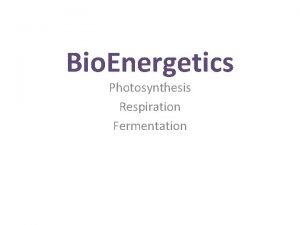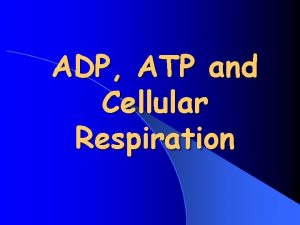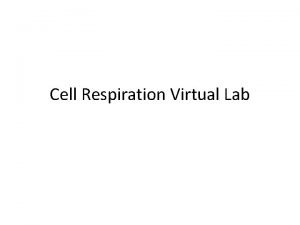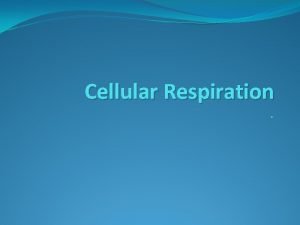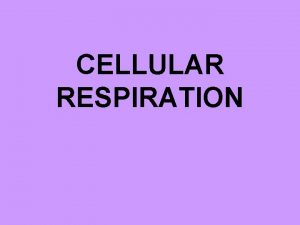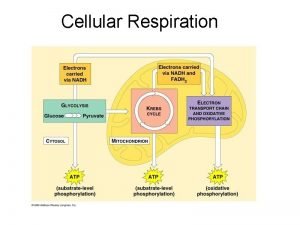Cellular Respiration What is Cellular Respiration l Cellular









- Slides: 9

Cellular Respiration

What is Cellular Respiration? l Cellular Respiration is the process by which all organisms break the chemical bonds in carbohydrates to release energy.

Carbohydrates l l l Carbohydrates are used as a fuel source for all organisms. Carbon – hydrogen bonds store a lot of energy. Carbon – carbon bonds store a lot of energy. Carbon – oxygen bonds store less energy Hydrogen – oxygen bonds store the least energy.

Release of Energy l l In cellular respiration, the highest energy bonds in sugar are broken and replaced with lower energy bonds. The extra energy from the bonds is captured for use in the cell.

Formula for Cellular Respiration C 6 H 12 O 6 + 6 O 2 6 CO 2 + 6 H 2 O + Energy Reactants: C 6 H 12 O 6 + 6 O 2 Products: 6 CO 2 + 6 H 2 O

Chemical Respiration: Details l Sugar is taken into the cell in the cytoplasm and the central bond of the sugar is broken. • This step produces 2 ATP l The pieces of sugar molecule pass into the mitochondria.

Chemical Respiration: Details l l l Oxygen comes into the mitochondria. The highest energy bonds (C-H; C-C) bonds break. The freed atoms reform into lower energy O-H and C-O bonds.

Chemical Respiration: Details l l At the end, the sugar and oxygen has been rearranged into lower energy molecules – H 2 O and CO 2. The water is either used in the cell or leaves the cell. The carbon dioxide leaves the cell. The body gains 34 more ATP per molecule of sugar.

Mass and Respiration l When an organism undergoes respiration, the mass decreases. • Since the carbon dioxide leaves the body, most of that mass is lost.
 Internal and external respiration
Internal and external respiration Internal respiration vs external respiration
Internal respiration vs external respiration Difference between autotrophs and heterotrophs
Difference between autotrophs and heterotrophs Cellular respiration equation
Cellular respiration equation Cellular respiration steps
Cellular respiration steps Cellular respiration virtual lab
Cellular respiration virtual lab The process of cellular respiration occurs in *
The process of cellular respiration occurs in * What type of cell performs cellular respiration
What type of cell performs cellular respiration Chapter 9: cellular respiration: harvesting chemical energy
Chapter 9: cellular respiration: harvesting chemical energy Krebs cycle occurs in
Krebs cycle occurs in


